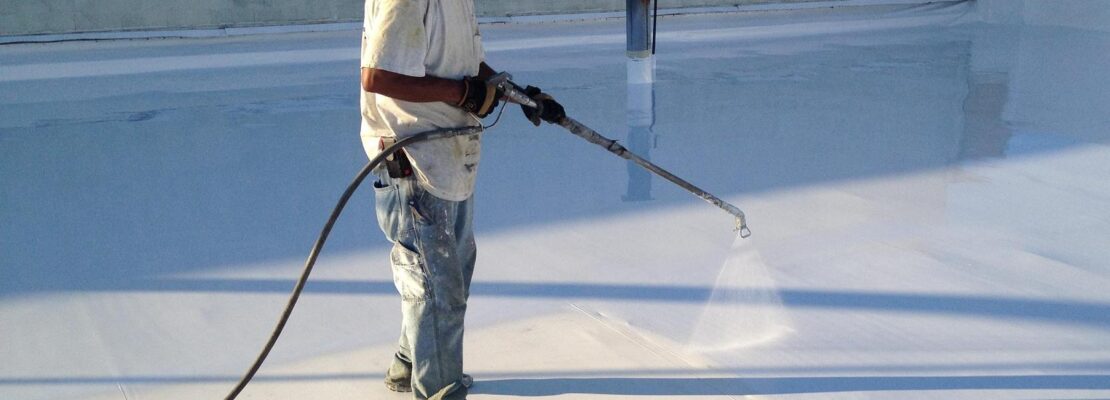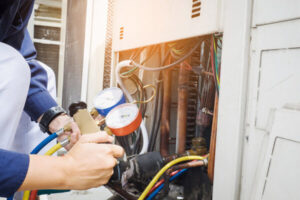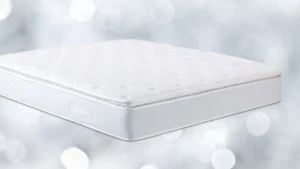Welcome to the diverse world of flat roof coatings, where possibilities abound and protection thrives! In this article, we will delve into the fascinating realm of flat roof coatings, exploring their many benefits, types, and how they can transform your roof into a durable and reliable shield against the elements. So, let’s dive in and uncover the secrets of this exciting topic.
Understanding Flat Roof Coatings
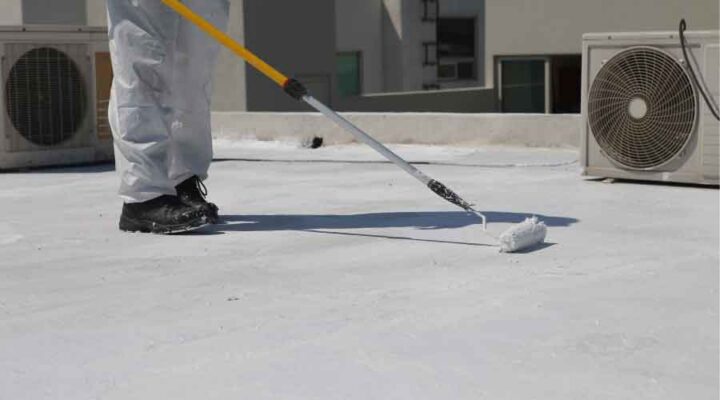
Flat roof coatings serve as a crucial line of defense for your building, shielding it from moisture, UV rays, and other environmental hazards. Their primary purpose is to provide a protective barrier that enhances the roof’s longevity while minimizing the need for costly repairs or replacements. By applying a suitable flat roof coating, you can enjoy many advantages beyond mere protection.
Advantages of Using Flat Roof Coatings
Flat roof coatings offer a host of benefits that make them an attractive choice for property owners. They act as a shield against leaks, cracking, and weather damage, extending the lifespan of your roof. Additionally, they can enhance the energy efficiency of your building by providing insulation and reflectivity, leading to potential cost savings. Moreover, flat roof coatings are often easy to apply, making them a convenient option for both DIY enthusiasts and professional contractors.
Common Types of Flat Roof Coatings
Within the world of flat roof coatings, several types are available, each with its own unique characteristics and suitability for different applications. Let’s explore the most commonly used types:
- Acrylic Coatings – They are popular due to their versatility and ease of application. They offer excellent UV resistance and weatherproofing properties, ensuring your roof remains well-protected. Acrylic coatings are known for their affordability and ability to adhere to a variety of surfaces.
- Silicone Coatings – Renowned for their exceptional durability and flexibility. They form a seamless, waterproof membrane that can withstand extreme weather conditions and provide excellent UV protection. They also possess self-healing properties, reducing the risk of cracks and leaks.
- Polyurethane Coatings – Excel in terms of impact resistance and durability. They can withstand heavy foot traffic and are highly resistant to damage from hail, debris, or other physical stressors. Polyurethane coatings offer excellent waterproofing capabilities, making them suitable for roofs exposed to standing water.
- Bituminous Coatings – Also known as asphalt coatings, they have long been favored for their waterproofing abilities. They are highly effective in protecting flat roofs from moisture infiltration and are often used in commercial and industrial applications. Bituminous coatings can be reinforced with various materials to enhance their strength and durability.
Now that we have a solid understanding of flat roof coatings and their advantages let’s explore each option in greater detail.
Option 1: Acrylic Coatings
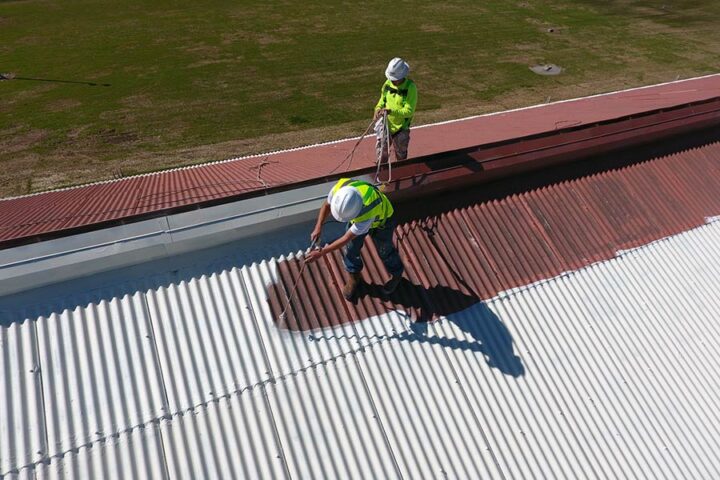
These are a popular choice for flat roofs due to their versatility, affordability, and ease of application. They offer a range of benefits that contribute to the protection and longevity of the roof.
Characteristics and Benefits
Acrylic coatings are known for their excellent UV resistance, which helps prevent damage from prolonged sun exposure. They also offer strong waterproofing properties, ensuring your roof remains well-protected from moisture infiltration. They create a seamless, protective membrane that acts as a barrier against leaks, cracks, and other forms of weather damage.
One of the significant advantages is their ability to adhere to a variety of surfaces, including metal, concrete, and single-ply membranes. This versatility makes them suitable for a wide range of flat roof applications. They are available in different colors, allowing for customization and aesthetic enhancements.
Application Process
The application typically involves several steps to ensure proper adhesion and optimal performance. Surface preparation is essential and may involve cleaning the roof surface, repairing any existing damage, and ensuring it is free from debris. Applying a primer can enhance the coating’s adhesion to the roof substrate.
Acrylic coatings can be applied using various methods, including spraying, rolling, or brushing. They are generally applied in multiple layers to achieve the desired thickness and coverage. Each layer needs to dry before the next one is applied. It’s important to follow the manufacturer’s guidelines and recommendations for proper application and curing.
Suitable Roof Types
Acrylic coatings are suitable for a wide range of roof types, including low-slope and flat roofs commonly found in residential, commercial, and institutional buildings. They can be applied to different substrates, such as metal, concrete, modified bitumen, or single-ply membranes. Whether you have a small residential flat roof or a large commercial building, acrylic membranes offer a cost-effective solution for protection and durability.
Longevity and Durability
The longevity can vary depending on factors such as climate, roof substrate, and maintenance. However, with proper installation and regular maintenance, they can provide reliable protection for approximately 10 to 15 years. Regular inspections and periodic recoating can prolong the lifespan of the coating and ensure optimal performance.
Option 2: Silicone Coatings
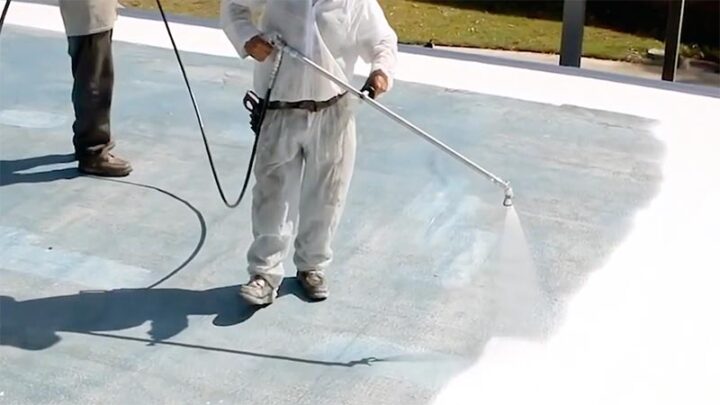
Silicone coatings are renowned for their durability, flexibility, and excellent weather resistance. They offer robust protection for flat roofs, particularly in areas with harsh weather conditions or high UV exposure.
Characteristics and Benefits
Silicone coatings form a seamless, flexible membrane that adapts to the roof’s movements without cracking or peeling. This flexibility allows them to withstand thermal expansion and contraction, making them highly durable. They provide exceptional UV resistance, preventing premature aging and degradation caused by sun exposure.
Water resistance is another notable benefit. They create a waterproof barrier that effectively prevents leaks and water infiltration. They are also self-healing with the ability to seal small cracks and imperfections over time, further enhancing their waterproofing capabilities.
Application Process
The application process of silicone coatings is similar to other flat roof coatings. It begins with surface preparation, ensuring the roof substrate is clean, dry, and debris-free. Priming may be necessary to enhance adhesion, particularly on certain roof substrates.
They can be applied using various methods, such as spraying or rolling. The number of layers required depends on the manufacturer’s recommendations and the desired thickness. Each layer should be allowed to cure before the next one is applied. It’s important to follow the specific application guidelines the coating manufacturer provides.
Suitable Roof Types
Silicone coatings are suitable for a wide range of roof types, including flat roofs commonly found in residential, commercial, and industrial buildings. They can be applied to various substrates, such as metal, concrete, modified bitumen, or single-ply membranes. They offer excellent adhesion to these surfaces, ensuring a strong and long-lasting bond.
Weather Resistance and UV Protection
One of the standout features of silicone coatings is their exceptional weather resistance. They can withstand extreme temperatures, high humidity, and heavy rainfall without compromising their performance. They have a high degree of elasticity, allowing them to expand and contract with temperature fluctuations, reducing the risk of cracks or damage.
They also provide outstanding UV protection. They reflect a significant portion of the sun’s rays, minimizing heat absorption and reducing the strain on the cooling system of the building. This can contribute to energy efficiency and lower cooling costs. The UV resistance helps prevent degradation and prolong the roof’s lifespan.
With their durability, flexibility, and impressive weather resistance, silicone coatings are an excellent choice for flat roofs that are exposed to challenging environmental conditions.
Option 3: Polyurethane Coatings
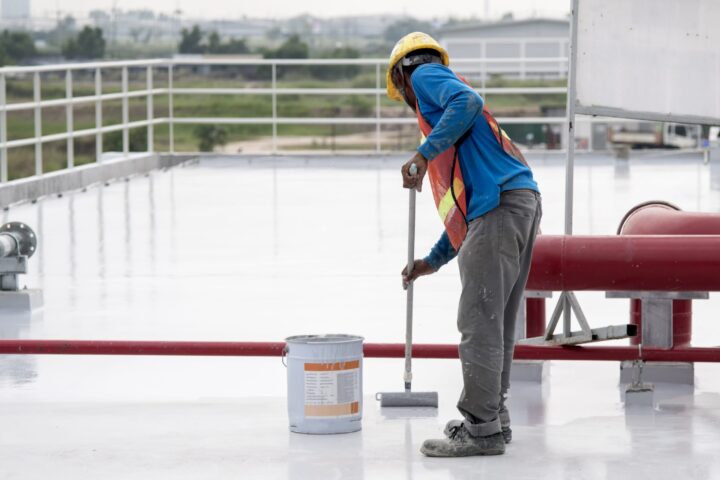
Polyurethane coatings offer a robust solution for flat roofs, combining durability, flexibility, and excellent impact resistance. They are designed to withstand heavy foot traffic and various environmental stressors, making them particularly suitable for roofs that may experience frequent activity or exposure to potential damage.
Characteristics and Benefits
Polyurethane coatings form a seamless, protective layer over the roof surface, providing exceptional waterproofing capabilities. They can withstand standing water, effectively prevent leaks and moisture infiltration, and offer impressive flexibility, allowing them to adapt to the natural movements of the roof without cracking or peeling. Additionally, they possess excellent adhesion properties, ensuring a long-lasting bond with the roof substrate.
They also contribute to energy efficiency. They provide insulation, helping to regulate indoor temperature and reduce heating or cooling costs. Moreover, these coatings are available in a range of colors, allowing for customization and aesthetic enhancements.
Application Process
Applying polyurethane coatings involves several steps to ensure proper adhesion and optimal performance. The process typically includes surface preparation, priming, and the application of the polyurethane coating. Surface cleaning and repair may be necessary to ensure a smooth and even substrate. Priming helps improve the coating’s adhesion, enhancing its longevity.
The polyurethane coating is typically sprayed or rolled onto the roof surface during application. Multiple layers may be necessary depending on the desired thickness and performance requirements. Professional installation is recommended to ensure accurate application and maximize the coating’s benefits.
Suitable Roof Types
Polyurethane coatings are versatile and can be applied to various roof types, including flat roofs commonly found in residential, commercial, and industrial buildings. They are particularly beneficial for roofs with high foot traffic or exposure to potential impact or mechanical stress. They can provide an effective protective layer, whether your roof is made of concrete, metal, or other materials.
Flexibility and Impact Resistance
One of the key advantages is their exceptional flexibility. They can accommodate the natural expansion and contraction of the roof due to temperature changes without cracking or compromising their integrity. This flexibility ensures long-term performance and minimizes the risk of water infiltration or damage.
Furthermore, polyurethane coatings offer remarkable impact resistance, protecting the roof from hail, falling debris, or other physical stressors. This durability extends the roof’s lifespan, reducing the need for frequent repairs or replacements.
Option 4: Bituminous Coatings
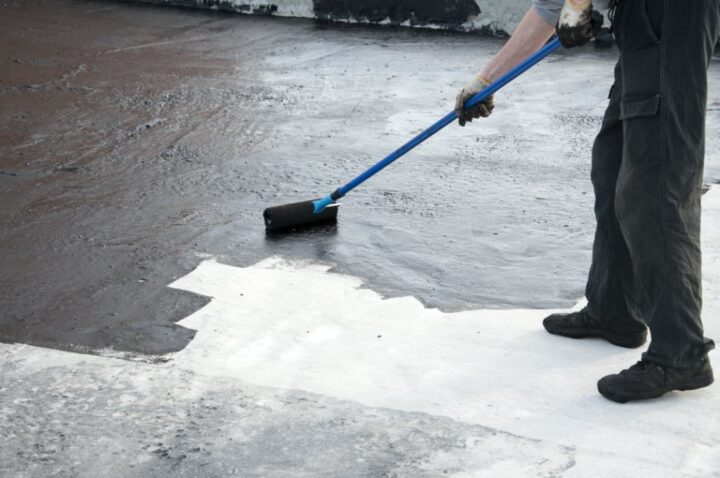
Also known as asphalt coatings, they have a long-standing reputation for their reliable waterproofing properties. They consist of bitumen, a sticky, black, and highly viscous material, mixed with other components to enhance its performance. Bituminous coatings are commonly used in commercial and industrial settings where robust protection is paramount.
Characteristics and Benefits
They form a durable and impermeable barrier against water penetration, ensuring excellent waterproofing for flat roofs. These coatings effectively seal the roof surface, preventing leaks and water damage. Bitumen, the primary component, provides exceptional adhesion to various substrates, including concrete, metal, and asphalt.
One of the notable benefits is their ability to withstand harsh weather conditions. They exhibit excellent resistance to UV rays, extreme temperatures, and general weathering, ensuring long-lasting performance. Moreover, they offer fire resistance, providing an added layer of safety for buildings.
Application Process
The application typically involves a multi-step process. It starts with surface preparation, which includes cleaning, repairing, and priming the roof substrate. Surface primers improve adhesion and promote the proper bonding of the coating to the roof.
They can be applied using various methods, including spray application, brush, or roller. The coating is carefully spread over the roof surface, ensuring even coverage and a consistent thickness. Multiple layers may be applied, depending on the desired level of protection and the manufacturer’s recommendations.
It’s important to note that these coatings require proper ventilation during application and curing. Adequate airflow helps the coating dry and cure effectively, ensuring optimal performance.
Suitable Roof Types
Bituminous coatings are widely used in different roof types, including flat roofs commonly found in commercial, industrial, and institutional buildings. They are compatible with various substrates, such as concrete, metal, and asphalt. Whether you have a large industrial facility or a small commercial building, they can provide reliable waterproofing and protection.
Waterproofing Properties
Their primary purpose is to provide superior waterproofing for flat roofs. They create a continuous, seamless membrane that effectively seals the roof surface, preventing water penetration and leaks. Bituminous coatings have excellent resistance to standing water, making them suitable for roofs with poor drainage or areas prone to heavy rainfall.
These coatings also offer protection against other environmental elements such as UV rays, which can cause premature aging and roof deterioration. By forming a protective barrier, they help extend the roof’s lifespan and minimize the need for costly repairs or replacements.
Factors to Consider When Choosing a Flat Roof Coating
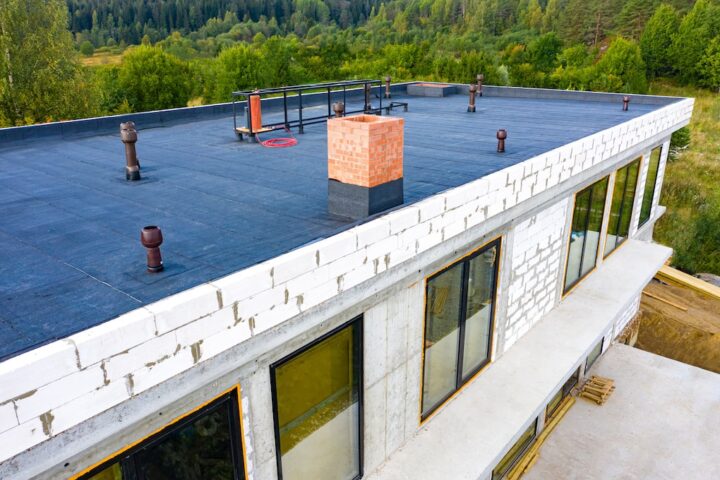
When selecting a flat roof coating, several factors should be considered to ensure the right choice for your specific needs. These factors include:
- Climate and Weather Conditions – The climate of your location plays a crucial role in determining the suitable flat roof coating. Consider factors such as temperature extremes, humidity, rainfall frequency, and exposure to UV radiation. Each coating type has its own weather resistance properties, and choosing the one that aligns with your climate conditions will provide optimal performance and longevity.
- Roof Substrate and Condition – The material and condition of your roof substrate are important considerations. Different coatings may adhere better to certain substrates, so it’s essential to ensure compatibility. Additionally, the condition of the roof, including any existing damage or structural issues, should be evaluated before applying a coating.
- Reflectivity and Energy Efficiency – Reflective coatings can help reduce heat absorption and lower the building’s cooling demands. Energy-efficient coatings with high solar reflectance can significantly impact the building’s energy consumption and contribute to cost savings over time. Consider the reflectivity properties of the coating when aiming for energy efficiency.
- Maintenance Requirements – Each flat roof coating has its own maintenance requirements, such as periodic inspections, cleaning, or reapplication. It’s crucial to consider the level of maintenance you are willing to commit to and choose a coating that aligns with your maintenance capabilities and schedule.
Considering these factors will guide you in making an informed decision and selecting the most suitable flat roof coating for your specific requirements.

